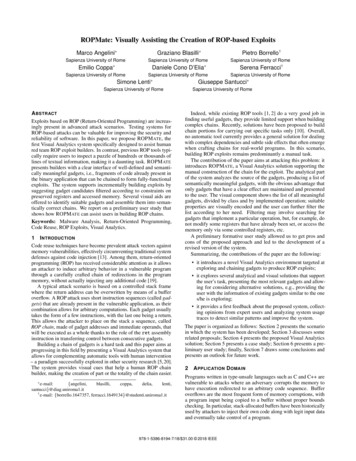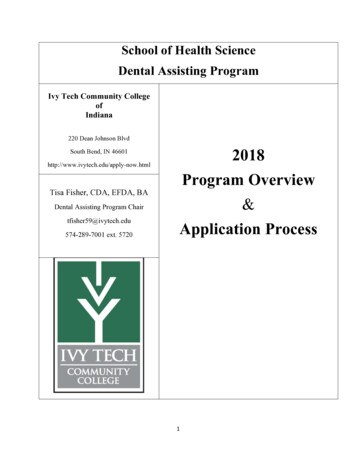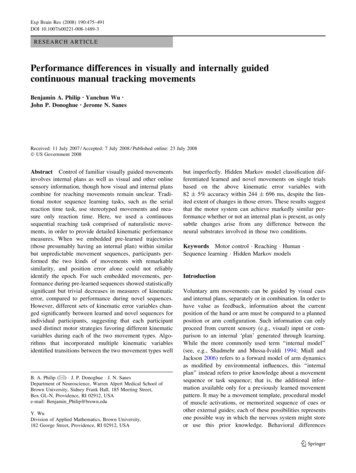
Transcription
ROPMate: Visually Assisting the Creation of ROP-based ExploitsMarco Angelini*Graziano Blasilli*Pietro Borrello†Sapienza University of RomeSapienza University of RomeSapienza University of RomeEmilio Coppa*Daniele Cono D’Elia*Serena Ferracci†Sapienza University of RomeSapienza University of RomeSapienza University of RomeSimoneLenti*Giuseppe Santucci*Sapienza University of RomeA BSTRACTExploits based on ROP (Return-Oriented Programming) are increasingly present in advanced attack scenarios. Testing systems forROP-based attacks can be valuable for improving the security andreliability of software. In this paper, we propose ROPM ATE, thefirst Visual Analytics system specifically designed to assist humanred team ROP exploit builders. In contrast, previous ROP tools typically require users to inspect a puzzle of hundreds or thousands oflines of textual information, making it a daunting task. ROPM ATEpresents builders with a clear interface of well-defined and semantically meaningful gadgets, i.e., fragments of code already present inthe binary application that can be chained to form fully-functionalexploits. The system supports incrementally building exploits bysuggesting gadget candidates filtered according to constraints onpreserved registers and accessed memory. Several visual aids areoffered to identify suitable gadgets and assemble them into semantically correct chains. We report on a preliminary user study thatshows how ROPM ATE can assist users in building ROP chains.Keywords: Malware Analysis, Return-Oriented Programming,Code Reuse, ROP Exploits, Visual Analytics.1 I NTRODUCTIONCode reuse techniques have become prevalent attack vectors againstmemory vulnerabilities, effectively circumventing traditional systemdefenses against code injection [13]. Among them, return-orientedprogramming (ROP) has received considerable attention as it allowsan attacker to induce arbitrary behavior in a vulnerable programthrough a carefully crafted chain of redirections in the programmemory, without actually injecting any additional code [19].A typical attack scenario is based on a controlled stack framewhere the return address can be overwritten by means of a bufferoverflow. A ROP attack uses short instruction sequences (called gadgets) that are already present in the vulnerable application, as theircombination allows for arbitrary computations. Each gadget usuallytakes the form of a few instructions, with the last one being a return.This allows the attacker to place on the stack a sequence, calledROP chain, made of gadget addresses and immediate operands, thatwill be executed as a whole thanks to the role of the ret assemblyinstruction in transferring control between consecutive gadgets.Building a chain of gadgets is a hard task and this paper aims atprogressing in this field by presenting a Visual Analytics system thatallows for complementing automatic tools with human intervention– a paradigm successfully explored in other security research [5, 20].The system provides visual cues that help a human ROP chainbuilder, making the creation of part or the totality of the chain ci}@diag.uniroma1.it† e-mail: {borrello.1647357, ferracci.1649134}@studenti.uniroma1.it* e-mail:Sapienza University of RomeIndeed, while existing ROP tools [1, 2] do a very good job infinding useful gadgets, they provide limited support when buildingcomplex chains. Recently, solutions have been proposed to buildchain portions for carrying out specific tasks only [10]. Overall,no automatic tool currently provides a general solution for dealingwith complex dependencies and subtle side effects that often emergewhen crafting chains for real-world programs. In this scenario,building ROP exploits remains predominantly a manual task.The contribution of the paper aims at attacking this problem: itintroduces ROPM ATE, a Visual Analytics solution supporting themanual construction of the chain for the exploit. The analytical partof the system analyzes the source of the gadgets, producing a list ofsemantically meaningful gadgets, with the obvious advantage thatonly gadgets that have a clear effect are maintained and presentedto the user. The visual component shows the list of all meaningfulgadgets, divided by class and by implemented operation; suitableproperties are visually encoded and the user can further filter thelist according to her need. Filtering may involve searching forgadgets that implement a particular operation, but, for example, donot modify some registers that have already been set, or access thememory only via some controlled registers, etc.A preliminary formative user study allowed us to get pros andcons of the proposed approach and led to the development of arevised version of the system.Summarizing, the contributions of the paper are the following: it introduces a novel Visual Analytics environment targeted atexploring and chaining gadgets to produce ROP exploits; it explores several analytical and visual solutions that supportthe user’s task, presenting the most relevant gadgets and allowing for considering alternative solutions, e.g., providing theuser with the information of existing gadgets similar to the ones/he is exploring; it provides a first feedback about the proposed system, collecting opinions from expert users and analyzing system usagetraces to detect similar patterns and improve the system.The paper is organized as follows: Section 2 presents the scenarioin which the system has been developed; Section 3 discusses somerelated proposals; Section 4 presents the proposed Visual Analyticssolution; Section 5 presents a case study; Section 6 presents a preliminary user study; finally, Section 7 draws some conclusions andpresents an outlook for future work.2A PPLICATION D OMAINPrograms written in type-unsafe languages such as C and C arevulnerable to attacks where an adversary corrupts the memory tohave execution redirected to an arbitrary code sequence. Bufferoverflows are the most frequent form of memory corruptions, witha program input being copied to a buffer without proper boundschecking. In particular, stack-allocated buffers have been historicallyused by attackers to inject their own code along with legit input dataand eventually take control of a program.978-1-5386-8194-7/18/ 31.00 2018 IEEE
Table 1: Gadget categorization used in ROPM ATEC LASSD riteMemReadMemOpWriteMemOpStackPtrOpOtherLoad constant value into a registerSet to zero a registerCopy value from a register to a registerUnary arithmetic/logical oper. over a registerBinary arithmetic/logical oper. over registersRead value from memoryWrite value into memoryBinary operation with memory inputBinary operation with memory outputAlter stack pointer valueAny other operationmov rdi, offset myGlobBufmov rbx, 0x68732F6E69622Fmov qword ptr [rdi], rbxmov rax, 0x3bmov rsi, 0x0mov rdx, 0x0syscall#######O PERATIONrax 10rax 0rax rcxrax 1rax rbxrax [rcx 8][rcx 8] raxrax [rcx 8][rcx 16] raxesp 8syscallG1 D1G2 D2G3G2 D3G4 D4G5 D5G6E XAMPLEG ADGET I NSTANCEpop rax; retxor rax, rax; retmov rax, rcx; retinc rax; retadd rax, rbx; retmov rax, qword ptrmov qword ptr [rcxadd rax, qword ptradd qword ptr [rcxadd esp, 8; retsyscall; retroproproproproproproproproproproproprop[rcx 8]; ret 8], rax; ret[rcx 8]; ret 0x10], rax; ret ’’ p64(addr G1) p64(myGlobBuf) p64(addr G2) ’/bin/sh\x00’ p64(addr G3) p64(addr G2) p64(0x3b) p64(addr G4) p64(0x0) p64(addr G5) p64(0x0) p64(addr G6)# D1# D2# D3# D4# D5Figure 1: Traditional shellcode sequence (left), ROP counterpart (center), and Python script that generates the binary representation of the ROPchain (right) for executing system call execve("/bin/sh", NULL, NULL). Function p64 from the pwntools exploitation library is used toencode 64-bit representations. Immediate 0x68732F6E69622F is the Little-Endian encoding of the NULL-terminated ASCII representationfor "/bin/sh". Addresses of gadgets Gi and immediate operands D j are used to implement basic operations of the original shellcode. For thesake of readability, in the graphical representation of the chain we report the actual instructions inside each gadget instead of its address.Once operating systems designers started incorporating defensessuch as Data Execution Prevention (DEP), which hinders code injection by denying code execution from writable regions, attackersdevised more subtle and powerful exploitation techniques commonlyknown as code reuse attacks. Such attacks chain together existingcode fragments from the vulnerable application, granting an attackerthe same expressive power of a custom injected sequence1 .Return-oriented programming (ROP) is the most well-knownform of code reuse, and takes its name from the ret assemblyinstruction that is used to chain together existing code fragments(called gadgets) of the application. ret is commonly used in function epilogues to update the instruction pointer with a value previously stored on the stack to resume execution in the caller function.Gadgets can be found in libraries, and sometimes within theprogram itself, using tools that implement variants of the Galileodiscovery algorithm [19] such as ROPgadget [1] or ropper [2]. Depending on the size of analyzed code and the maximum length, thenumber of found gadgets can range from thousands for middle-sizedprograms, to tens of thousands for large libraries and programs [9].Gadgets are then analyzed and classified according to the functionalities they provide: in Table 1 we report a possible categorization thatwe use in the gadget classifier analytical component of ROPM ATE.Example. In Figure 1 we present a simple exploit that opens1 Codereuse attack techniques are usually Turing-complete [18].a shell on the machine with the same privileges of the vulnerableapplication; such an exploit is commonly referred to as shellcode.Before techniques such as DEP were adopted by operating systems,a shellcode consisted of assembly instructions to be injected in theprogram, as in the left portion of the figure. In particular, in thisexample a "/bin/sh" string is assembled in CPU register rbx, andthen copied to a writable memory area whose address is specifiedin register rdi. The shellcode then prepares the arguments forthe Linux execve system call used to spawn a shell: on a x8664 architecture, ordinal 0x3b for the call is put in register rax,the address of the string in register rdi, and the remaining twoarguments – both set to NULL – in rsi and rdx, respectively. Finally,instruction syscall is used to trigger the system call.An equivalent ROP chain for the shellcode is shown in the middlepart of Figure 1. We assume that an attacker placed the chain onthe stack so that the stack pointer rsp points to the beginning of thechain when the vulnerable program executes some ret instruction.This instruction updates the instruction pointer rip with the valuecurrently written on the top of the stack, then adjusts the stack pointerbefore execution continues from the new address in rip. As thestack grows from high to low addresses, rsp is moved to a higheraddress, i.e., it is incremented by 8 on a 64-bit machine.In our example, ret loads the address of gadget G1 into theinstruction pointer, and the updated stack pointer now points to D1 ,which contains the address &myGlobBuf of the buffer where we will2018 IEEE SYMPOSIUM ON VISUALIZATION FOR CYBER SECURITY (VIZSEC)
put the "/bin/sh" string. As the code of gadget G1 is executed, wemeet one peculiarity of ROP code: constants are usually loaded toregisters by means of pop instructions, which read a value from thetop of the stack, write it to the desired register, and then incrementrsp. When the next instruction in G1 is executed, which is a ret, thetop of the stack contains the address of gadget G2 : we can now seehow the ret instruction orchestrates the control flow in a ROP chain,by loading the address of the subsequent gadget in the instructionpointer and moving the stack pointer up the chain before executingthe gadget. Such process is iterated over the 7 gadgets that constitutethe chain, eventually invoking execve as in the original shellcode.Challenges. Building a ROP chain is not a trivial task. Whilefor a traditional shellcode an attacker can choose from the entireCPU instruction set whichever instruction s/he need to implementthe desired semantics, a ROP chain builder is strongly limited by thegadgets that are found during the discovery phase [18]. In particular,when looking for an instruction implementing a particular operationthe following problems may arise:1. No available gadget contains it. For instance, the chain builderis looking for a gadget that loads a constant value into a specificregister, say rbx, but no suitable one is found. In the chain ofFigure 1, we had to resort to a gadget G2 that loads a constantto a different register, specifically rax. Another possibilityis to use multiple gadgets to realize the intended operation:this happens for instance quite frequently for some arithmeticoperations for which gadgets are notoriously rare [19].2. A gadget is available, but comes with side effects. This isthe case of gadgets with more than one instruction before theending ret: for instance, gadget G3 of Figure 1 not only writesthe content of rax to memory, but also performs a bitwise ANDoperation, altering the contents of register rcx. In our examplewe do not use rcx to hold any relevant data for later use, thusthis side effect is harmless. However, in general side effectsmight clobber (i.e., overwrite) registers holding useful data,or perform unwanted memory operations that may make theprogram crash or ruin the chain.3. A gadget is available, but is problematic for subsequent operations. This case is more subtle, as an attacker has not only toconsider the current operation, but also subsequent ones thatwill use its results. This happens for instance when some datais written to some register r, gadgets for subsequent operationscan only read from different registers, and no other gadget canbe used to move data across r and any such register.In the light of these problems, a ROP chain builder is presentedwith a large amount of information originating in: (i) having manygadgets that differ only for subtle side effects, (ii) complex dependencies that may arise as the chain grows, and (iii) limitations onchoosing a gadget on the basis of the registers that should not beclobbered at a given point in the chain.While automatic construction of ROP exploits has been addressedin previous works, such as the seminal Q paper [18], most availabletools do not work properly in realistic scenarios. Due to the lack ofa publicly available working ROP compiler that meets the needs ofreal-world attackers, building ROP chains remains predominantly amanual task [10].Applications. In recent years a remarkable number of academicworks and security reports have highlighted the power of code reuseattacks for carrying out complex exploitations on mainstream software. A common belief is that most ROP exploits observed inthe wild have been written manually by very experienced attackerswhich, either for demonstration purposes or motivated by criminalreasons, are willing to devote a significant effort to building a chain.From a software house perspective, when a number of memorybugs are discovered in the development of its products, it is importantto quickly assess whether such bugs are vulnerabilities exploitableby an attacker, and how dangerous the possible consequences are.For this reason, a red team made of ethical hackers – either internalor hired in the market – can evaluate the feasibility of ROP-basedattacks, and to which extent such attacks can cause harm to the system. For instance, an attack might take place only under unrealisticoperating conditions, or the attacker has limited freedom in carryingout certain tasks. It is important to consider that producing a fix fora vulnerability and validating it before releasing it publicly mighttake considerable time. Also, in some cases previous ROP exploitsare adapted when variants of the original vulnerability surface lateron, such as in the case of the EPS component of Microsoft Office2 .Similar considerations might also apply for instance to companiesthat have to employ possibly buggy third-party components in, e.g.,mission-critical systems.3R ELATEDWORKIn cybersecurity, software vulnerabilities are considered one of themain attack vectors: the Visualization field presents several proposals coping with software analysis, ranging from code and structureanalysis [11,24] to reverse engineering [8], malware analysis [12,16],and support for red team activities [25]. Given the specific natureof the ROP chain building activity, to the best of our knowledgeno Visual Analytics solution has been previously proposed. In theremainder of this section, we discuss aspects of the ROP literaturethat are most related to our ideas.ROP Defenses. In the arms race between OS designers andexploit writers, a number of defenses [22] have been proposed duringthe last decade to counter code reuse attacks. Address Space LayoutRandomization (ASLR) [15] is one of the first defenses integratedinto modern operating systems: by randomly arranging the addressspace positions of key areas of a process, ASLR makes hard foran attacker to identify gadget addresses. However, ASLR does nottypically randomize the base address of the main executable, leavinga fruitful source for gadgets. Additionally, ASLR is often defeatedby leveraging a vulnerability that leaks the base address of a library.Several other defenses can be deployed to limit ROP attacks. Forinstance, G-Free [14] rewrites the application code to reduce thenumber of available gadgets, while TypeArmor [23] makes gadgetsfor function calls unusable outside legitimate control flows. Themain drawback of sophisticated ROP defenses [22] is that they eithercome with non-negligible overheads or require heavily customizedcompilation toolchains, making them less suitable for production environments. With respect to ROP mitigations shipped with the latestreleases of Microsoft Windows [3], a recent work [7] shows howthese countermeasures can be bypassed. The work also discusseshow to find find realistic expressive gadget sets even in the presenceof advanced ROP defenses.Automatic ROP Chain Builders. One missing element in theresearch landscape is a ROP chain building tool that meets the needsof real-world attackers, for which building a chain remains mainlya manual task [10]. Conversely, recent years have witnessed anincrease in the complexity of ROP chains, which moved from beingshort sequences aiming at bypassing DEP to enable code injection,to very complex behaviors encoded entirely in ROP [13]. Gadgetfinders, such as ROPgadget [1] and ropper [2], provide very limitedsupport to a user when building complex chains. While the mostsophisticated tools can attempt to generate chains for a few predefined tasks, such as making the stack executable, they lack flexibilityto support custom actions in an attack, and mostly importantly arobust methodology for dealing with gadget dependencies and subtleside effects automatically. As a consequence, they often fail andgenerate only partial chains that an attacker must complete manually,although in some cases such chains turn out to be a dead end.2 05/eps-processing-zero-days.html.2018 IEEE SYMPOSIUM ON VISUALIZATION FOR CYBER SECURITY (VIZSEC)
Figure 2: Overview of the ROPM ATE visual component. (A) The top bar is divided in three parts, from left to right: (A1) the Filter Barallows explicitly filtering the available gadgets by entering a search text; (A2) through the Memory Threshold it is possible to set a limit tothe memory usage of gadgets; (A3) through this button it is possible to load the binary from which to extract the gadgets. (B) The RegistersPane lists all the registers and allows defining a filter on gadgets based on the preservation of certain registers; (C) the Tree Pane shows all theavailable gadgets organized in a three-level taxonomy; (D) the Analysis Pane shows the details of a chosen gadget, while (E) the SimilarityPane shows all the gadgets that execute the same operation using MDS. Finally, (F) the Chain Pane shows the current state of the built chain.4T HE V ISUAL A NALYTICSSOLUTIONThe proposed solution aims at supporting the user in the wholeprocess from the gadgets extraction to the ROP chain deployment.This section introduces this process, then describes the analyticaland visual components that support it.As first step, the program under inspection is parsed by the analytical component that extracts the set of available gadgets; eachgadget is analyzed to identify its semantics and how it interactswith memory and registers. The subset of semantically meaningfulgadgets is then loaded in the visual component and the user can starther analysis. In order to build the chain, the user has to iterativelyrepeat the following steps: S/he selects an operation to add to the chain and chooses agadget with that semantics based on memory and registersconstraints (see also Table 1); S/he analyzes more deeply the chosen gadget and adds it to thechain if it is appropriate or looks for similar gadgets otherwise; When a gadget is added to the chain, the user checks the chainbehavior and optionally modifies it by reordering or deletingits gadgets.When the chain is complete, s/he can export it to a Python script forits binary encoding, a step that is common in the ROP practice.4.1The Analytical componentROPM ATE relies on different analytics, used in all the steps of theprocess, from the preprocessing step in which gadgets are characterized, to the management of the developed chain.Gadgets Semantics: Classification and Filtering. During thepreprocessing step, the analytical component analyzes the availablegadgets extracted from the program and identifies their semanticsusing a classification algorithm based on symbolic execution [6]. Itgroups gadgets that execute the same operation (excluding uselessgadgets) and that differ from each other in terms of memory andregisters usage. The identified operations are further grouped inclasses (see Table 1), thus creating a three-level taxonomy that makeseasier to navigate through the different gadgets. The taxonomyallows the user to quickly identify a subset of suitable gadgets;however selecting the right gadget(s) among them require to takeinto account side effects like the clobbering of registers or unwantedmemory operations. For this reason, each gadget representation isenriched with information regarding the reading, modification, ordereferencing of registers and memory operations. This informationwill be then conveyed through visual means to the user during thechain building process and can be used as further filter mechanisms.Gadgets Similarity. Once a subset of gadgets that execute thesame operation is identified, ROPM ATE is able to compute a dissimilarity function among them in order to facilitate their exploration.Given a gadget Gi , it analyzes its semantics and builds the set Sicontaining Gi and all the gadgets that execute the same operation.Si is then partitioned in Pi {Q0 , ., Qn } such that each subset Qhcontains all the gadgets that modify the same set of registers. Forevery pair (Q j , Qk ) Pi Pi , the dissimilarity function d(Q j , Qk ) iscomputed as follows:d(Q j , Qk ) (R j Rk ) (R j Rk ) with Rh being the set of registers modified by the gadgets of set Qh ,2018 IEEE SYMPOSIUM ON VISUALIZATION FOR CYBER SECURITY (VIZSEC)
(a) Classes(b) SemanticsFigure 3: Details of the Tree Pane showing the first two levels of the taxonomy of gadgets: (a) the first level of the tree shows the list of 11classes available for the binary and a histogram suggesting the number of operations for each class, (b) the second level of the tree shows thelist of 5 operations available for the UnOp class and a histogram to convey information regarding the number of gadgets for each such operation.and the relative dissimilarity matrix is built. That allows for quicklylocating substitutes of Gi when, for any reasons, Gi cannot be used.4.2The Visual componentThe first step while using ROPM ATE is to load the program underexamination (see Figure 2.A3); after that it is parsed by the analyticalcomponent that extracts and characterize gadgets as discussed inSection 4.1. Once the list of gadgets is extracted from the program,the user can start to build the ROP chain.The Tree Pane (see Figure 2.C) shows the taxonomy of gadgets,grouped by operations and classes. The taxonomy is representedas a tree allowing to quickly locate suitable gadgets based on thedesired operation by descending the tree. The first level of the treeshows the classes (see Figure 3a); a histogram aligned to the list ofclasses suggests the number of available operations for each class,with the width of the bars proportional to this number. Clicking ona class reveals the list of its operations (see Figure 3b). A secondhistogram is aligned to the list of operations; the width of the bars isnow proportional to the number of available gadgets.Once the desired operation is identified, the list of correspondinggadgets, partially ordered by ascending complexity (modeled as aheuristic of: number of dereferenced registers, number of modifiedregisters, and stack pointer displacement, in this order) is availableby clicking on it (see Figure 4). A gadget is identified by its assembly code and its representation is enriched by means of two visualelements. Each gadget has an associated memory requirement baron its right; the width of the bar represents the space in the stack required by the gadget to work properly (i.e., to execute its instructionsand being able to transfer execution to the next gadget), according toa logarithmic scale that allows for perceiving the differences amongsmall values. The color of the bar encodes the stack occupation withrespect to a memory threshold. A green color indicates that the sizedoes not exceed the threshold, while a red color indicates that it does.The memory threshold has a predefined value but at any time theuser can change this value according to her needs (see Figure 2.A2).The second visual mean is the dereferenced registers matrix,aligned to the right of the gadgets and showing the registers usedto access the memory; each column represents a register and therows are aligned with the gadgets. Each entry of the matrix is filledby a rectangle if the gadget dereferences the register (suggestingthat the register has to be properly set to safely use it to access thememory). The rectangle has a full height if the condition is notcurrently satisfied by the chain and it has half height otherwise; thisvisual encoding has been chosen to prioritize the identification ofdependencies to resolve in case of gadget selection. Each rectanglehas a color associated to the register, but the possibly high numberof registers in 64-bit code led us to use this matrix representationFigure 4: Details of the 18 available gadgets for the rdi 1 operation of Figure 3b. Gadgets are identified by their assembly code;the width of the memory requirement bars, attached to the right, isproportional to the binary logarithm of the required memory occupation (the red color of 2 boxes means that the requirement of thegadgets exceeds the memory threshold); the aligned dereferencedregisters matrix shows which registers are dereferenced by eachgadget, the entries are rectangles with full height if the dependencyis not satisfied (e.g., rax register encoded in green), and have halfheight otherwise (e.g., rsi and rdi registers encoded in gray andlight blue.)instead of the listing of the registers for each gadget to take advantageof the horizontal positioning and make usage patterns evident.The Registers Pane (see Figure 2.B) allows for further refiningthe search space in order to face the possible side effects: the user isable to select which registers should be preserved, for example tosafely choose gadgets without clobbering registers already set in thechain. The pane contains all the registers, identifiable by their nameand color and a checkbox that, when is checked, filters from the TreePane all the gadgets that modify the register. The user has also thepossibility to display only gadgets that do not access memory to beable to choose simpler gadgets first, by checking the Avoid Memorycheck-box. Furthermore, through the Filter Bar (see Figure 2.A1),the user is allowed to explicitly define the filter by entering a searchtext: e.g., “rdi” filters gadgets using that register. S/he is able toselect all and only the gadgets that execute a specific operation, thatexplicitly set up a certain register, or that use it to access memory.Once the user selects a gadget, additional information is displayedin the Analysis Pane (see Figure 2.D). The box shows the operationcarried out by the gadget, its assembly code, its memory address,2018 IEEE SYMPOSIUM ON VISUALIZATION FOR CYBER SECURITY (VIZSEC)
Figure 5: The box in the Analysis Pane provides details about one ofthe gadgets available for the rdi 1 operation: the gadget modifiesthe rcx and rdi registers, dereferences rdi and rax, and needs 8bytes in memory to work properly; furthermore, its assembly code isdetailed in the bottom of the box. By clicking on the box, the gadgetwill be added to the chain.the registers that it modifies and the ones that it dereferences; anexample is provided in Figure 5. By clicking on the box, the gadgetis added to the chain.While analyzing a gadget, the user might realize that it doesnot respect certain constraints and thus seeks equivalent gadgetswith different side effects. The Similarity Pane
ROP-based attacks can be valuable for improving the security and reliability of software. In this paper, we propose ROPMATE, the first Visual Analytics system specifically designed to assist human red team ROP exploit builders. In contrast, previous ROP tools typi-cally require users to inspect a puzzle of hundreds or thousands of










